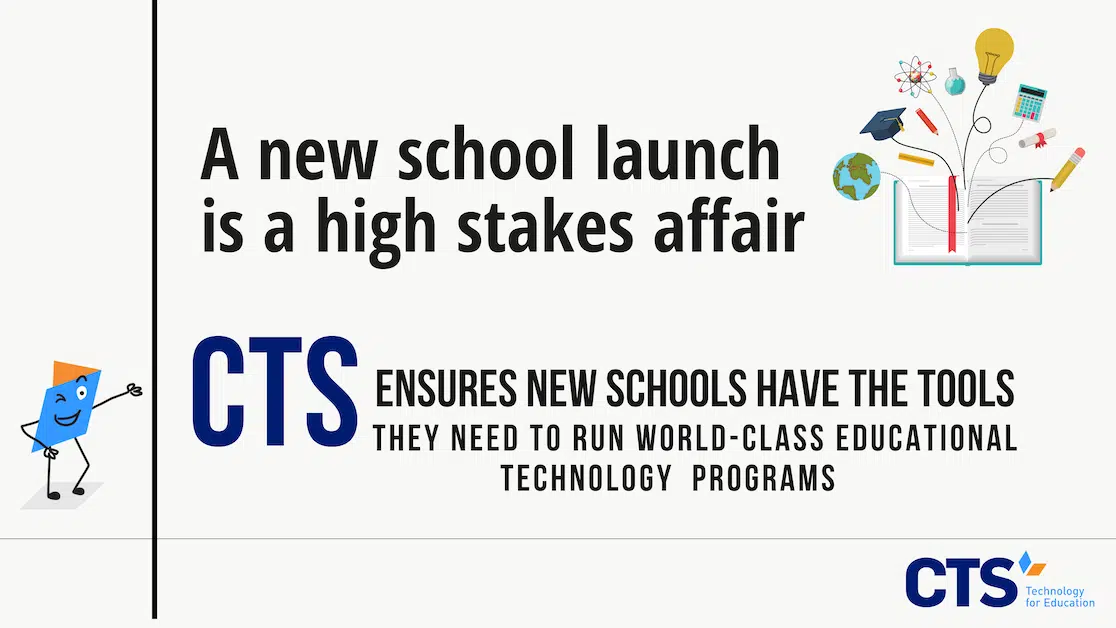New school launches require stellar technology support.
As schools increasingly depend on technology to deliver instruction to their students, managed IT services have become more central than ever to day-to-day school operations. From phone and bell systems to SMART boards, projectors, and student devices, schools rely on dependable technology to educate students. If a wireless network falters, a projector bulb burns out, or a teacher can’t access her Google Classroom, precious instructional minutes can go to waste.
New schools can similarly ill afford less-than-reliable technology, which often constitutes a considerable portion of their launch budgets. It’s not just a question of getting the technology to the building, however. It’s also about what role the school’s leaders envision that technology playing: does the school have a robotics lab that will require specific software or a science curriculum with a substantial online component? What about new math programs with online modules that differentiate instruction in real-time? Does the school plan on having students and teachers video conference with one another? If yes, does the school’s wireless network have the bandwidth to support multiple conferences at once?
The answers to these questions all derive from the school’s unique instructional mission, which, as we’ve discussed, increasingly requires custom technology solutions. As new schools begin planning their launches, CTS is ready to help. Armed with in-depth experience in the education and technology sectors, our team of client support managers and engineers know what it takes–and how hard it can be–to successfully launch a new school. Our goal is to put an end to the never-ending loop of meetings with landlords, general contractors, and third-party vendors that can plague new school launches. We believe the more time school leaders can think about instructional priorities, the better.
At CTS, we begin by creating a roadmap of your new school’s unique vision.
Before we begin setting-up new hardware, installing wireless access points, or tagging devices, we need to understand your new school’s mission. What role, exactly, will technology play in day-to-day instruction, and what are the key milestones between today and your school’s launch that we need to keep in mind?
First, the extent to which technology is used by teachers, students, and support staff will inform the type and quantity of hardware and software we’ll need to help the school purchase. Here, questions of scale dominate: smaller schools can obviously get away with fewer resources, while those with larger class sizes will require more. Of course, depending on the school’s financial constraints and growth plan, it can make sense to make certain investments now rather than purchasing additional hardware or software as the school grows.
Questions of scale are also central to student device purchasing. While some schools are content with a “traveling” Chromebook cart for an entire grade, others prioritize a 1:1 student-device ratio (i.e., each student has an assigned device, such as a Chromebook, that travels with them to and from school). For new schools that desire a 1:1 student-device ratio, early procurement is key, a fact underscored by the pandemic. As the beginning of the year approaches, thousands of schools across the country will begin to scramble for Chromebooks. School leaders who know they want a particular number of devices for their student body can make their purchases ahead of time, avoiding any last-minute orders.
Finally, it’s important to have a sense of the school’s pre-launch calendar to ensure all technology-related needs are met in a timely fashion. For instance, some schools will bring teachers back to campus early for professional development, so it’s critical that all staff devices are ready for pick-up and that the building’s wireless networks are functioning properly. Similarly, a new school may want to host an open house prior to its launch that requires specific audiovisual equipment, such as a project or SMART Board. Establishing these dates early helps technology companies like CTS create timelines that work for schools’ unique schedules.
Next, we get into the details of your new school launch. What facilities-related issues keep you up at night?
Once CTS has worked with school leadership to identify key instructional technology needs and established a timeline for opening, it’s time to get into the nitty-gritty of facilities management.
Particularly in older or repurposed buildings, buyer’s remorse can quickly take over. From leaking ceilings, lack of wireless cabling, faulty alarms, or doors whose keys can’t be found, schools often uncover issues in their new building with precious weeks to spare. Fortunately, CTS has experience tackling some of the toughest, most complex facilities-related issues that confront new schools.
With enough lead time, our team can identify potential “dead zones” in your school that could allow a child or classroom to temporarily exit the grid. Through a process of trial and error–coupled with the hunch that comes with prior experience–our team can identify potential problem areas in your new facility and develop creative solutions to ensure each square inch of the building is put to maximal use.
For new schools whose buildings have little or no technology-related infrastructure, we work with school leaders to identify any potential budgetary constraints and optimize coverage based on schools’ fiscal realities. Even if we can’t outfit an entire school in year one or install a network to support a 1:1 student-device ratio, we’ll come up with a solution that balances budgetary constraints with the school’s unique instructional mission.
At the end of the day, it’s all about instruction. What role does technology play in your new school’s curriculum?
Beyond any facilities needs, however, in order to create a truly comprehensive roadmap for a school’s technology needs, our team needs to understand the role the school envisions technology playing in day-to-day instruction, including any hardware the school expects teachers to use on a regular, even daily, basis.
Of course, SMART Boards, projectors, Chromebooks, and staff laptops are the most common tools in schools’ technology arsenal, but most buildings will also require extensive phone and bell systems, audiovisual equipment, cameras, and other hardware that go beyond a common understanding of schools’ technology needs. The same holds for online instructional platforms, which schools increasingly use to differentiate instructions for their students in real-time. Identifying which online platforms the school plans to use, the data integrations that need to occur for the platforms to work, and any other standard roll-out information are all necessary to successfully executing the platforms’ launch.
The extent and nature of students’ device use can also inform the firewall, filtering, and other safety features our team includes with the new school’s devices. While we take pains to ensure our systems are CIPA-compliant, it’s important to discuss potential options with the school so that students always have access to the content they need while also remaining safe online.
Finally, when it comes to device tracking, it’s important to know whether the school plans to allow students to take home their devices each day or whether they’ll remain stored in individual, grade-level, or school-wide carts for use during the day. Helping the school proactively create systems to manage their devices, along with identifying a “golden source” of device-tracking information, can save valuable time during the annual school close-out and launch process.
Cost is also a factor in almost any decision at a new school. We recommend systems and platforms that make sense for our partners’ budgets.
Finally, and perhaps most importantly for any new school, we recognize that cost is a factor in all instructional and non-instructional decisions school leaders make. CTS’s transparent service packages give new schools the flexibility they need to gradually scale up their managed IT services to align with their fiscal constraints.
At the same time, our experience in managed IT allows us to recommend products that save schools money, while also remaining true to their instructional missions. Even if your school can’t afford a 1:1 student-device ratio or the newest model of SMART Board, our team can make recommendations that get your school at least part of the way there while also establishing longer-term procurement plans.
In addition, our experience with the E-rate program ensures that our fulfillment of your school’s bid occurs on time and on budget, preserving precious fiscal resources for other instructional priorities.
At CTS, we help new schools launch successfully so they can accomplish their unique missions.
Our team is fully committed to accomplishing the unique mission of your new school. From procuring the requisite technology infrastructure, to advising school leaders on device models and instructional software, CTS is deeply invested in using technology to impact student achievement.
With our transparent service packages and track record of successful school launches, our team can develop solutions to your school’s complex, facilities-related technology issues that threaten to compromise your launch, which we know is crucial to the organization’s long-term success.
Contact us today to learn more about our services and how we can help your new school fulfill its unique mission.




